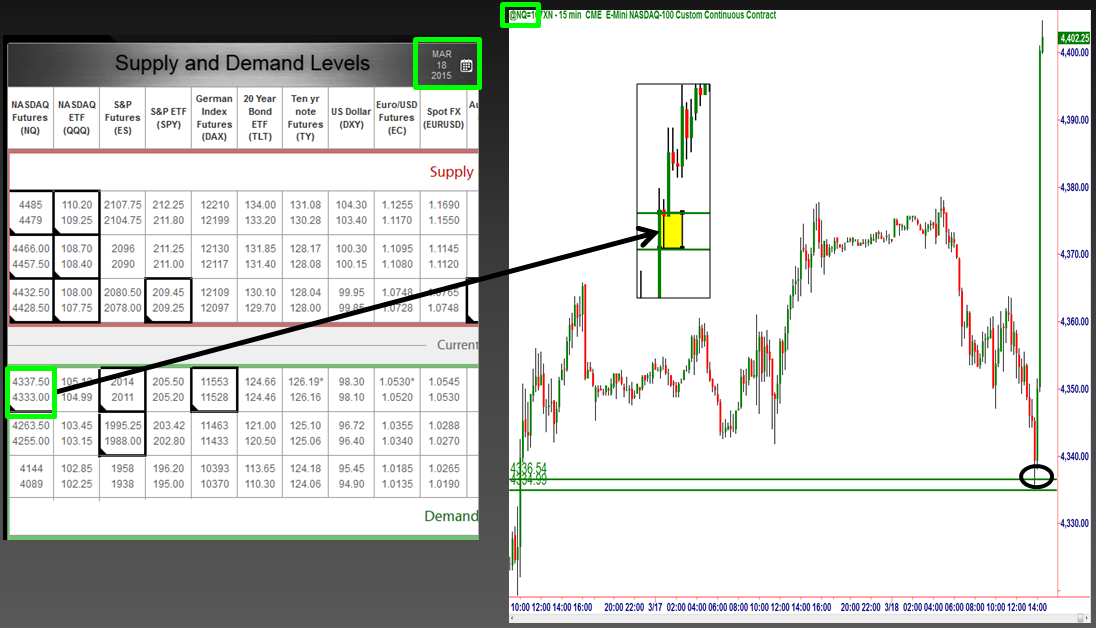![]()
As I have written about so many times, the movement of price in any and all free markets is simply a function of an ongoing supply and demand equation. Trading opportunity exists when this simple and straight forward equation is “out of balance.” Meaning prices turn at price levels where supply and demand are most out of balance, in any market. The key for the market speculator is to have the ability to identify what this picture of opportunity looks like on a price chart. The lowest risk, highest reward, and highest probability time to buy into a market, for example, is to buy at price levels way down on the supply/demand curve where demand exceeds supply. At these price levels profit margins to the upside are huge and the risk is low. Unfortunately, price does not fall to these types of desired levels as much as we would like and when it does, it doesn’t stay their long. Of course, this is because demand exceeds supply in such a big way.
Another thing to consider is how and why prices in markets fall to these desired sale prices. The stronger the news event, the greater mass perception is created. The stronger the mass perception, the more buying and selling happens and this moves price. Last week we had a Fed day. While the news was not all that unexpected, price moved fast and far.
Supply/Demand Grid 03/18/15: NASDAQ Buying Opportunity, Fed Day
Many traders ask me the same question regarding news days like the Fed day. They ask if they should pull their orders from the market around news events like the Fed news day last week and not trade. I have two answers… first, if you’re new to trading and don’t know how to identify real supply and demand in the markets, don’t trade around news events (don’t trade period). Second, if you are good at identifying real supply and demand in a market, you really want to be ready with orders in the market around news events. When it comes to price movement the news typically speeds up what was going to happen anyway. As you can see on the NASDAQ Futures chart above, just prior to the Fed announcement, price declined in somewhat strong fashion right into our demand zone from that mornings supply/demand grid. Next, price exploded away from that demand zone. Whatever the news is, however strong it is, the movement of price is always a function of pure supply and demand, a simple numbers game.
Wall Street tells us that you can’t time the market’s turning points and that it’s a waste of time. Of course they tell us that. If the average person could time the market’s turning points no one would need Wall Street. I would argue that the average person can time the market’s turning points like we did with the NASDAQ. It’s not that we are always right and can pick every turning point in a market. With our rules however, I would argue that the average person can time the market’s turning points with a very high degree of accuracy.
Note: All information on this page is subject to change. The use of this website constitutes acceptance of our user agreement. Please read our privacy policy and legal disclaimer. Opinions expressed at FXstreet.com are those of the individual authors and do not necessarily represent the opinion of FXstreet.com or its management. Risk Disclosure: Trading foreign exchange on margin carries a high level of risk, and may not be suitable for all investors. The high degree of leverage can work against you as well as for you. Before deciding to invest in foreign exchange you should carefully consider your investment objectives, level of experience, and risk appetite. The possibility exists that you could sustain a loss of some or all of your initial investment and therefore you should not invest money that you cannot afford to lose. You should be aware of all the risks associated with foreign exchange trading, and seek advice from an independent financial advisor if you have any doubts.
Editors’ Picks

AUD/USD falls toward 0.6600 amid risk aversion
AUD/USD drops toward 0.6600 in Asian trading on Tuesday, as recent mixed Australian labour market data and renewed concerns about the health of the Chinese economy undermine the Aussie amid a softer risk tone and a pause in the US Dollar decline. Traders now look to the delayed US NFP report for some impetus.

USD/JPY stays in the red below 155.00 amid BoJ rate hike bets, US data awaited
USD/JPY holds moderate losses below 155.00 in the Asian session on Tuesday. The Japanese Yen gains ground on expectations that the Bank of Japan will raise interest rates at the upcoming policy meeting on Friday. Traders will closely monitor key US data, including Nonfarm Payrolls, Retail Sales, and Purchasing Managers Index, which are due later in the day.

Gold defends $4,300 as focus shifts to US NFP, PMI data
Gold price holds the $4,300 level, easing from the highest since October 21 in the Asian trading hours on Tuesday. The precious metal stays afloat on further US Federal Reserve rate cut bets. The US Nonfarm Payrolls report will take center stage later on Tuesday. Also, the US Retail Sales and Purchasing Managers Index will be published.

Ethereum: BitMine acquires 102,259 ETH as price plunges 5%
Ethereum treasury company BitMine Immersion scaled up its digital asset stash last week after acquiring 102,259 ETH since its last update. The purchase has increased the company's holdings to 3.96 million ETH, worth about $11.82 billion. BitMine aims to accumulate 5% of ETH's circulating supply.

NFP preview: Complex data release will determine if Fed was right to cut rates
The long wait is over, and the Bureau of Labor Statistics in the US will release nonfarm payrolls reports for both November and October at 1330 GMT on Tuesday. The overall NFP figure for October is expected to be -10k, however, it is expected to be influenced by a massive 130k drop in federal department workers.
RECOMMENDED LESSONS
Making money in forex is easy if you know how the bankers trade!
I’m often mystified in my educational forex articles why so many traders struggle to make consistent money out of forex trading. The answer has more to do with what they don’t know than what they do know. After working in investment banks for 20 years many of which were as a Chief trader its second knowledge how to extract cash out of the market.
5 Forex News Events You Need To Know
In the fast moving world of currency markets where huge moves can seemingly come from nowhere, it is extremely important for new traders to learn about the various economic indicators and forex news events and releases that shape the markets. Indeed, quickly getting a handle on which data to look out for, what it means, and how to trade it can see new traders quickly become far more profitable and sets up the road to long term success.
Top 10 Chart Patterns Every Trader Should Know
Chart patterns are one of the most effective trading tools for a trader. They are pure price-action, and form on the basis of underlying buying and selling pressure. Chart patterns have a proven track-record, and traders use them to identify continuation or reversal signals, to open positions and identify price targets.
7 Ways to Avoid Forex Scams
The forex industry is recently seeing more and more scams. Here are 7 ways to avoid losing your money in such scams: Forex scams are becoming frequent. Michael Greenberg reports on luxurious expenses, including a submarine bought from the money taken from forex traders. Here’s another report of a forex fraud. So, how can we avoid falling in such forex scams?
What Are the 10 Fatal Mistakes Traders Make
Trading is exciting. Trading is hard. Trading is extremely hard. Some say that it takes more than 10,000 hours to master. Others believe that trading is the way to quick riches. They might be both wrong. What is important to know that no matter how experienced you are, mistakes will be part of the trading process.
The challenge: Timing the market and trader psychology
Successful trading often comes down to timing – entering and exiting trades at the right moments. Yet timing the market is notoriously difficult, largely because human psychology can derail even the best plans. Two powerful emotions in particular – fear and greed – tend to drive trading decisions off course.


